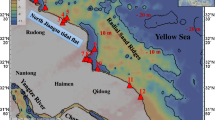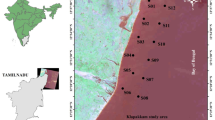Abstract
Surface samples are used to determine onshore-offshore variations in heavy metal concentrations on tidal flats on Chongming and Hengsha Islands in the Yangtze Estuary, China. The Mann-Whitney U-Test suggests that proximity to the estuarine turbidity maximum does not result in significantly higher metal concentrations on tidal flats. Principal Components Analysis shows that grain-size is the primary control on metal concentrations, reflecting the occurrence of salt marsh and mud and sand flats. Sediment quality is comparable to that of pristine estuaries because of dilution by high river sediment loads.






Similar content being viewed by others
References
Ackermann F, Bergmann G, Schieichert U (1983) Monitoring of heavy metals in coastal and estuarine sediments—a question of grain-size: <20 μm versus <60 μm. Environ Technol Lett 42:317–328
Buckley DE, Winters GV (1992) Geochemical characteristics of contaminated surficial sediments in Halifax Harbour: impact of waste discharge. Can J Earth Sci 29:2617–2639
Chen Z, Kostaschuk RA, Yang M (2001) Heavy metals on tidal flats on the Yangtze Estuary, China. Environ Geol 40:742–747
Daskalakis KD, O’Connor TP (1995) Normalization and elemental sediment contamination in the coastal United States. Environ Sci Technol 29:470–477
Dauvalter VA (1998) Heavy metals in the bottom sediments of the Inari-Pasvik lake-river system. Water Resour 25:451–457
de Groot AJ (1995) Metals and sediments: a global perspective. In: Allen HE (ed) Metal contaminated aquatic sediments. Ann Arbour Press Inc, Michigan, pp 1–20
Forstner U (1985) Chemical forms and reactivities of metals in sediments. In: Leschber R, Davis RD, Hermite PL (eds) Chemical methods for assessing bio-available metals in sludges and soils. Elsevier Applied Science Publishers, New York, pp 1–30
Joliffe IT (1986) Principal component analysis. Springer, Berlin Heidelberg New York
Karuppia M, Gupta G (1998) Chronological changes in toxicity of and heavy metals in sediments of two Chesapeake Bay tributaries. J Hazard Waste 59:159–166
Li JF, Zhang C (1996) Tidal flat morphological development and coastal land reclamation in Shanghai. J Chin Geogr 6:84–91
Menon MG, Gibbs RJ, Phillips A (1998) Accumulation of muds and metals in the Hudson River estuary turbidity maximum. Environ Geol 34:214–222
Stewart WDP (1972) Estuarine and brackish waters—an introduction. In: Barnes RSK, Green J (eds) The estuarine environment. Applied Science Publishers Ltd, London, pp 1–9
Yang SL (1998) The role of scirpus marsh in attenuation of hydrodynamics and retention of fine sediment in the Yangtze Estuary. Estuar Coast Shelf Sci 47:227–233
Yang SL (1999a) A study of coastal morphodynamics on the muddy islands in the Changjiang River Estuary. J Coast Res 15:32–44
Yang SL (1999b) Tidal wetland sedimentation in the Yangtze Delta. J Coast Res 15:1090–1099
Yang SL (1999c) Sedimentation on a growing intertidal island in the Yangtze River mouth. Estuar Coast Shelf Sci 49:401–410
Zhang J (1999) Heavy metal compositions of suspended sediments in the Changjiang (Yangtze River) estuary: significance of riverine transport to the ocean. Cont Shelf Res 19:1521–1543
Zhang J, Huang WW, Wang Q (1990) Concentration and partitioning of particulate trace metals in the Changjiang (Yangtze River). Water Air Soil Pollut 52:52–70
Zhang W, Yu L, Hutchinson SM, Xu S, Chen Z, Gao X (2001) China’s Yangtze Estuary: I. Geomorphic influence on heavy metal accumulation in intertidal sediments. Geomorphology 41:195–205
Zwolsman JJG, van Eck GTM, Burger G (1996) Spatial and temporal distribution of trace metals in sediments from the Scheldt Estuary, south-west Netherlands. Estuar Coast Shelf Sci 43: 55–79
Acknowledgements
The authors wish to thank KC Tan and the Canadian International Development Agency for financial support. Meng Yang and Zhanghua Wang provided invaluable assistance with field and laboratory work.
Author information
Authors and Affiliations
Corresponding author
Rights and permissions
About this article
Cite this article
Gorenc, S., Kostaschuk, R. & Chen, Z. Spatial variations in heavy metals on tidal flats in the Yangtze Estuary, China. Env Geol 45, 1101–1108 (2004). https://doi.org/10.1007/s00254-004-0968-5
Received:
Accepted:
Published:
Issue Date:
DOI: https://doi.org/10.1007/s00254-004-0968-5




